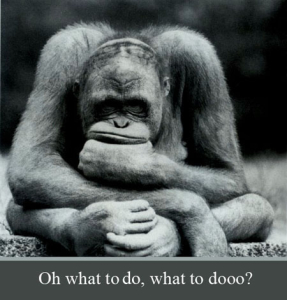
I don’t know who first said that, but I keep coming across it lately and I agree. It’s not possible to draw factual conclusions about things that haven’t happened yet (although that doesn’t stop us from trying)…which raises an interesting question: How useful are facts in evaluating innovative ideas?
Facts are important. It’s no wonder that we prize having them…in science, in the courts, in education and in business. Facts, when they’re favorable, can be comforting. They give us a sense of security and control. They confirm our expectations and reinforce our beliefs. Facts are definitive. We can say that an assertion of fact is true or false, right or wrong, correct or incorrect. Facts have the power to give us answers, remove uncertainty, settle arguments and confirm our knowledge and expertise. They inform decisions and guide our actions. Without facts, the kind of evidence-based decision making that keeps us grounded in the realities around us…is impossible. Facts are what give us the real world reality checks we need to find and sustain success. They can also prompt fresh insights.
So it’s understandable that we so often use the facts we have to judge the ideas we’re considering, but is that really a sound approach? The facts can only take us so far. They can only bring us up to the present. Where the facts end is exactly where innovation begins—in the present moment.
To generate the ideas that lead to innovation, we have to rely on our hunches, intuitions, speculations, hypotheses and intentions (exactly the sorts of things that arouse skepticism among hard-nosed business people). Yet we expect people to argue for their ideas and we expect sound arguments to be based on facts. To compound the challenge, most of us are willing to extend our own assumptions and beliefs into the future, as though they’re still facts, yet refuse to allow others to extend their facts into the future—unless they match our own.
It sounds like an irreconcilable conflict, a chasm that can’t be crossed. But successful innovators do cross that chasm; they are able to sell their ideas, not by abandoning rationality or ignoring the facts but by reframing their analysis.
Interpret Facts and Evaluate Ideas
Skilled innovators recognize that facts and ideas are very different things, so they handle them in different ways: Facts are interpreted and ideas are evaluated. That may sound redundant. In some contexts interpretation and evaluation are virtually synonymous, but in the way I’m using them here they are almost polar opposites.
- Interpreting Facts
Interpretation fits facts because it focuses on what’s already happened. In order to interpret something, we need to have some information, event or experience to make sense of. So it’s a look back at what we know or have observed. We ask questions like, “What does this mean?” and, “How can I make sense of this?” Innovators interpret facts for the purpose of gaining fresh insights that can inform their ideas. They also interpret facts to gauge the impact or success of their ideas, once those ideas have been applied (once something has occurred).
- Evaluating Ideas
Evaluation fits ideas because ideas are forward looking. They represent unfulfilled possibilities and future intentions. An innovator evaluates ideas based on their ability to reach desired objectives. So we ask questions like, “Will this work?” and “What’s the risk?” and “What resources are needed?” The goal is to develop strong possibilities that will have the desired impact.
Both types of analysis are important to innovation. But getting these mixed up is like using a knife as a screwdriver. It may at times get the job done, but it’s the wrong tool…and we’ve all witnessed the results of this confusion:
- Bias
Using our objectives to interpret facts (rather than to evaluate ideas) is likely to create bias. It’s allowing our hopes and desires and agendas to influence our judgment. The effect is misread situations, wishful thinking and denial, which leads to bad decisions and unwise risks. To reach clear-eyed factual interpretations we need to set aside our hopes and dreams and expectations and rely on the data—the facts.
- Dogma
Using facts (instead of objectives) to evaluate ideas can become dogmatic. Allowing our prior assumptions and beliefs to preclude future possibilities may eliminate viable options, hampering innovation and staying locked in the status quo. Using what we know about the past to evaluate future prospects may sound practical, but it’s likely to filter out the most innovative ideas (or they’re not very innovative).
Facts are useful for understanding context and circumstances. Facts help us clarify problems and identify challenges as we come up with innovative ideas. They’re also crucial to accurately gauging the results of our actions as we explore and experiment. But by their nature, facts are weak predictors of an untested idea’s value and potential success.
To innovate successfully, we need to keep a bright line between these two very different kinds of analysis.
Get the new Special Report, Innovation Essentials: The Four Greatest Ways We stop Ourselves…In Business and in Life. Download a free copy at: http://www.insightfusion.com/SpecialReport.asp

Leave A Comment